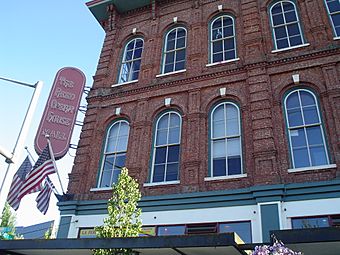Reed Opera House and McCornack Block Addition facts for kids
Quick facts for kids |
|
|
Reed Opera House and McCornack Block Addition
|
|
|
U.S. Historic district
Contributing property |
|

Reed Opera House
|
|
| Location | 189 and 177 Liberty Street, NE Salem, Oregon |
|---|---|
| Area | less than one acre |
| Built | 1869 |
| Architect | Rhodes, G.W. |
| Architectural style | Italianate |
| Part of | Salem Downtown State Street – Commercial Street Historic District (ID01001067) |
| NRHP reference No. | 78002302 |
| Added to NRHP | March 8, 1978 |
The Reed Opera House, often called The Reed, is a historic building in downtown Salem, Oregon. It opened on September 27, 1870. This building has been a place for shows and a shopping center for many years. Its unique Italianate style, made of brick, led to it being added to the National Register of Historic Places in 1978.
Building the Reed Opera House
Construction of the Reed Opera House started in 1869 and finished in 1870. G. W. Rhodes was the architect who designed it. Cyrus Adams Reed built the opera house. He had a plan with the State of Oregon to create space for the state's lawmakers, the Supreme Court, and the State Library.
However, during construction, Oregon's new leaders decided not to use the building for government offices. Since the building was almost done, Reed changed his plans. He added seven shops on the ground floor. The second and third floors became an opera house. The extra space was turned into a hotel.
Grand Opening and Early Fun
The Reed Opera House officially opened with a big party. This party was for the new Oregon Governor, La Fayette Grover. The building quickly became the main spot for entertainment and social events in Salem. It hosted many traveling plays and opera groups. It was also used for political meetings and community gatherings.
Many famous people visited the Reed Opera House. These included local star Hallie Parrish Hinges and artist Thomas Nast. Susan B. Anthony, a leader for women's rights, also spoke there. Famous writer Mark Twain and presidents Rutherford B. Hayes and Benjamin Harrison visited. Even John Philip Sousa's famous band performed at The Reed.
Changes Over Time
On April 20, 1900, the Reed Opera House theater closed. A new theater, the Grand Theater, had opened nearby. The Grand Theater was more modern and had an easier entrance on the ground floor.
Soon after, Joseph Meyers and Sons, who managed the property, changed the theater. They turned it and most of the shops into a department store. In 1902, a two-story building was added to the Reed Opera House. This new part was used for a furniture store. In 1920, Miller's Department Store bought both buildings and used them.
The Reed Today
Miller's Department Store stayed in the buildings until 1976. Then, a realtor named Coburn Grabenhorst Sr. and architects Phil Settecase and Howard Smith bought them. They spent about $1,000,000 to update the buildings. This gave the Reed its current look.
The updated Reed Opera House had many small shops and restaurants. These were on different levels, including the lower level, first floor, mezzanine, and second floor. The Reed was very popular for a while. But then, a large mall was built nearby in the late 1980s. This caused financial problems for the Reed.
In 1993, Bourne Properties bought the Reed Opera House. Later, in 2003, Roger Yost bought the building from Bourne Properties. Yost, who used to work for Jantzen Apparel, started a big project to fix up and expand the building. He wanted to bring back some of its original beauty.
Yost spent $50,000 to remodel the Trinity Ballroom and the kitchen. He also spent $175,000 to modernize the elevators. He recreated parts of the original building's roof, like the pediment and corona. This cost $180,000, but he won a $100,000 prize from Salem's Urban Renewal agency to help with the restoration. Yost also added old advertisements for Jantzen Swimwear, his former company, throughout the public areas of The Reed.

